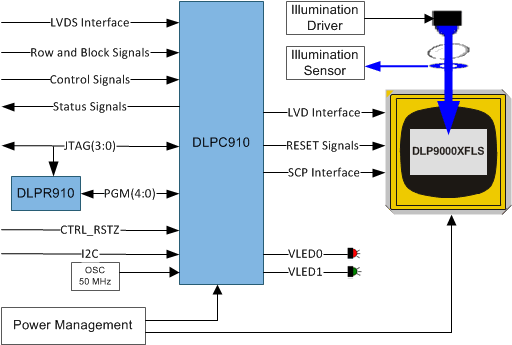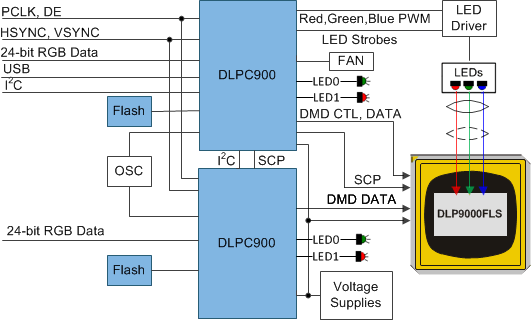DLPS036B September 2014 – October 2016 DLP9000
PRODUCTION DATA.
- 1 Features
- 2 Applications
- 3 Description
- 4 Revision History
- 5 Description (continued)
- 6 Pin Configuration and Functions
-
7 Specifications
- 7.1 Absolute Maximum Ratings
- 7.2 Storage Conditions
- 7.3 ESD Ratings
- 7.4 Recommended Operating Conditions
- 7.5 Thermal Information
- 7.6 Electrical Characteristics
- 7.7 Timing Requirements
- 7.8 Capacitance at Recommended Operating Conditions
- 7.9 Typical Characteristics
- 7.10 System Mounting Interface Loads
- 7.11 Micromirror Array Physical Characteristics
- 7.12 Micromirror Array Optical Characteristics
- 7.13 Optical and System Image Quality
- 7.14 Window Characteristics
- 7.15 Chipset Component Usage Specification
- 8 Parameter Measurement Information
- 9 Detailed Description
- 10Application and Implementation
- 11Power Supply Requirements
- 12Layout
- 13Device and Documentation Support
- 14Mechanical, Packaging, and Orderable Information
Package Options
Mechanical Data (Package|Pins)
- FLS|355
Thermal pad, mechanical data (Package|Pins)
Orderable Information
1 Features
-
High Resolution 2560×1600 (WQXGA) Array
- > 4 Million Micromirrors
- 7.56-µm Micromirror Pitch
- 0.9-Inch Micromirror Array Diagonal
- ±12° Micromirror Tilt Angle (Relative to Flat State)
- Designed for Corner Illumination
- Integrated Micromirror Driver Circuitry
- Two High Speed Options
- DLP9000X With a Single DLPC910 Digital Controller
- 480 MHz Input Data Clock Rate
- Up to 61 Giga-Bits Per Second (with Continuous Streaming Input Data)
- Up to 14989 Hz (1-Bit Binary Patterns)
- Up to 1873 Hz (8-Bit Gray Patterns With Illumination Modulation)
- DLP9000 with Dual DLPC900 Digital Controllers
- 400 MHz Input Data Clock Rate
- Up to 38 Giga-Bits per Second (With Up to 400 Pre-Stored Binary Patterns)
- Up to 9523 Hz (1-Bit Binary Patterns)
- Up to 1031 Hz (8-Bit Gray Patterns Pre- Loaded With Illumination Modulation), External Input Up to 360 Hz
- Designed for Use With Broad Wavelength Range
- 400 nm to 700 nm
- Window Transmission 95% (Single Pass, Through Two Window Surfaces)
- Micromirror Reflectivity 88%
- Array Diffraction Efficiency 86%
- Array Fill Factor 92%
2 Applications
- Industrial
- Machine Vision and Quality Control
- 3D Printing
- Direct Imaging Lithography
- Laser Marking and Repair
- Medical
- Ophthalmology
- 3D Scanners for Limb and Skin Measurement
- Hyper-Spectral Imaging
- Hyper-Spectral Scanning
- Displays
- 3D Imaging Microscopes
- Intelligent and Adaptive Lighting
3 Description
Featuring over 4 million micromirrors, the high resolution DLP9000 and DLP9000X digital micromirror devices (DMDs) are spatial light modulators (SLMs) that modulate the amplitude, direction, and/or phase of incoming light. This advanced light control technology has numerous applications in the industrial, medical, and consumer markets. The streaming nature of the DLP9000X and its DLPC910 controller enable very high speed continuous data streaming for lithographic applications. Both DMDs enable large build sizes and fine resolution for 3D printing applications. The high resolution provides the direct benefit of scanning larger objects for 3D machine vision applications.
Device Information(1)
| PART NUMBER | PACKAGE | BODY SIZE (NOM) |
|---|---|---|
| DLP9000 | CLGA (355) | 42.20 mm x 42.20 mm x 7.00 mm |
| DLP9000X |
- For all available packages, see the orderable addendum at the end of the data sheet.
SPACE
Typical DLP9000X Application

Typical DLP9000 Application
